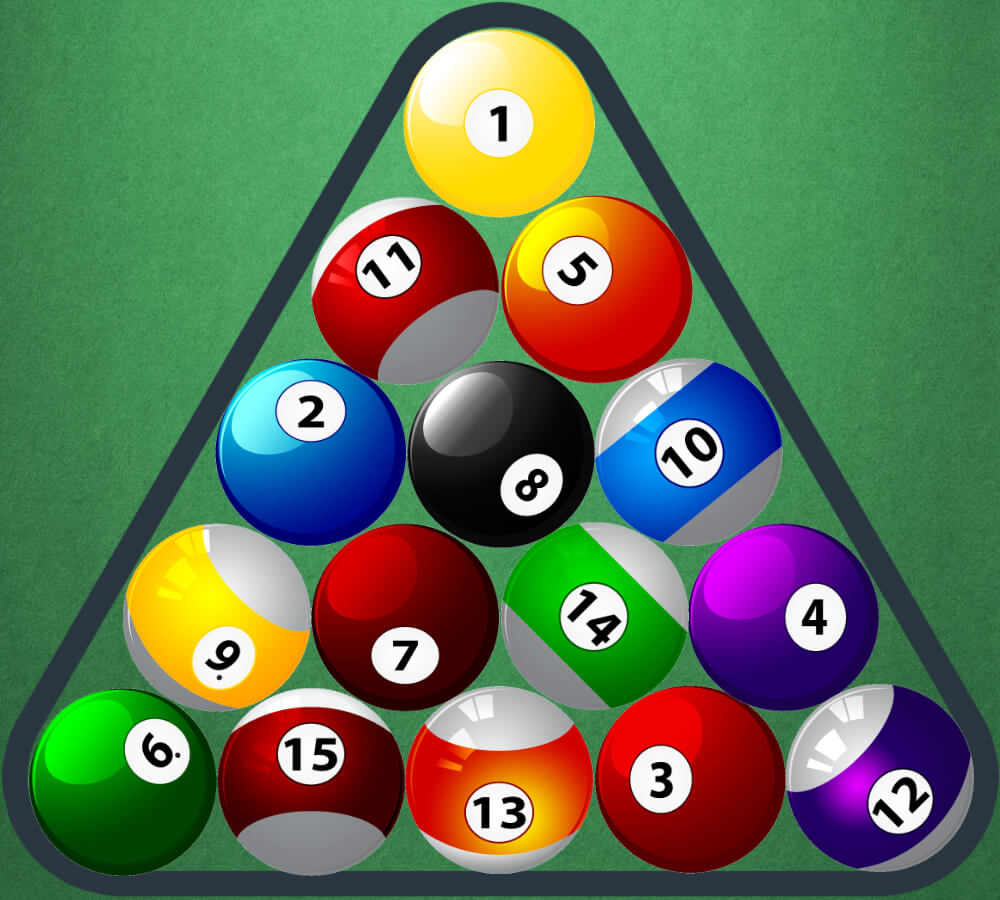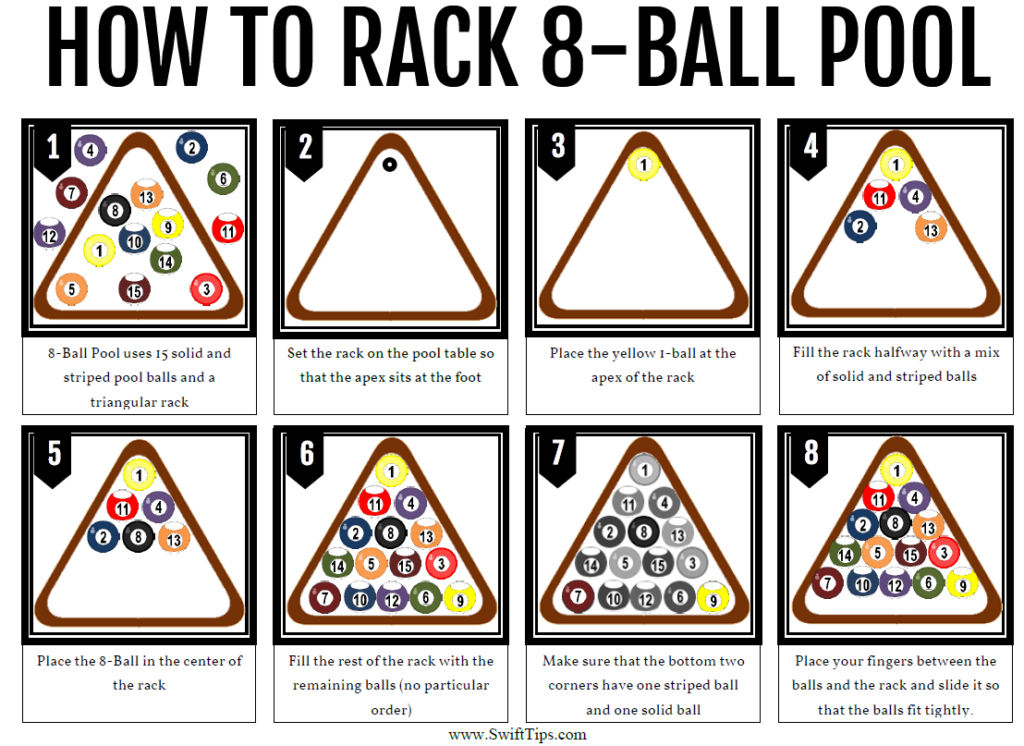Pool Racking Secrets: Master The Setup For A Winning Game!
Are you ready to elevate your pool game from casual to captivating? Mastering the art of racking the balls is not just a step; it's the very foundation upon which a successful and enjoyable pool experience is built.
The precision with which you set up the initial formation, or "rack," directly impacts the flow and outcome of the game. Neglecting this fundamental skill can lead to frustrating breaks, uneven ball distribution, and ultimately, a less satisfying match. The process, seemingly minor, is actually a cornerstone of strategic play, ensuring fairness, reliability, and enhanced enjoyment for all participants.
Before diving into the specifics, it is imperative to understand that the equipment plays a critical role. The primary tool is a pool rack, available in two common shapes: triangular and diamond. The triangular rack, with its classic design, is suitable for various games, including 8-ball, straight pool and others. In contrast, the diamond rack offers a unique setup suitable for games like 9-ball. Each configuration affects the game's dynamics, making the choice of rack a crucial first decision.
- Farnaz Arasteh Wife Of John Phillips Her Story Uncovered
- Christopher Masterson From Malcolm In The Middle To Dj What You Need To Know
| Aspect | Details |
|---|---|
| Type of Pool Rack | Triangular or Diamond |
| Dimensions (Triangle) | 11.25 inches / 28.81 cm (inner measurement) by 10 inches / 25.51 cm |
| Dimensions (Diamond) | 6.75 inches / 17.15 cm (inner measurement) by 10 inches / 25.51 cm |
| Games Best Suited | 8-ball, 9-ball, 10-ball, Straight Pool and Snooker |
| Purpose | To correctly position the balls at the start of the game. |
| Importance | A proper rack ensures a fair and balanced starting position, impacting the flow and outcome. |
| Key Consideration | Tightness of the ball formation. Balls should touch with no gaps. |
Now, let's explore how to master this crucial skill, focusing specifically on 8-ball pool. This game is the most widely played, making it an excellent starting point.
Setting up for 8-Ball Pool
The process begins by placing the triangle rack on the pool table, precisely over the designated "foot spot," which is typically marked by a dot. A fundamental rule governs the placement of the balls within the rack: No row or column should ever have three balls of the same type (solids or stripes) adjacent to one another. This rule is essential to ensure a balanced arrangement and a fair break.
- Sophie Rain Leaks What You Need To Know Amp The Spiderman Video
- Kannada Cinema 2025 Your Guide To Movies Legal Streaming Movierulz Alternatives
1. Apex Ball: The apex ball, the ball at the point of the triangle, is the most critical. It serves as the cornerstone for the rest of the balls in the rack. Often, the 8-ball is placed in the center of the triangle, but this is not always the case.
2. Corner Balls: Place one stripe ball and one solid ball in the bottom corners of the triangle rack. This placement creates variety and helps ensure a good spread on the break.
3. Filling the Rack: The remaining balls are filled randomly, ensuring that no column or row contains three balls of the same type, and that the balls are touching each other tightly.
4. Ball Placement Rows: Place the balls in the subsequent rows as follows: one ball in the first row, two balls in the second row, three balls in the third row, and four balls in the fourth row.
As a final check, roll the rack forward and backward to ensure no balls are sticking and that the balls are packed tightly together. A tight rack is a key factor for a successful break. The aim here is to have all balls touching, creating what is known as a "frozen" rack. These elements will lead to a more controlled and effective break.
Racking for Other Games: Adaptations and Considerations
While 8-ball is the most common, other games have specific racking requirements:
1. 9-Ball: A diamond rack is used for 9-ball, and the balls are arranged in numerical order, with the 1-ball at the apex and the 9-ball in the center. This setup provides a different strategic dynamic, encouraging more strategic and methodical play.
2. 10-Ball: This also uses a diamond rack, with the 1-ball at the apex. In this game, the 10-ball is placed in the center of the diamond. This arrangement demands precision and accuracy.
3. Straight Pool (14.1 Continuous): Players typically use a triangle rack, but the ball placement rules vary, often requiring the players to arrange the balls randomly.
The rules governing the placement of the balls are often dictated by the governing body or the local rules of play. For a standard rack, the stripe and solid balls are alternated. For a more competitive game, you might be required to alternate the balls in the second and fourth rows, so that the break is not predictable.
Technique: Achieving a Tight Rack
The primary goal is to achieve a "tight rack," where all the balls are touching, with no gaps. This is achieved by pushing the balls firmly forward as you place them into the rack. Additionally, a cue ball or another pool ball can be used to gently tap the balls down, ensuring they are locked tightly in position.
Once the rack is properly packed, hold the balls firmly in place and tap them down lightly with a cue ball or another pool ball, ensuring that the balls are in contact with each other. To remove the rack, the back of the triangle or diamond is lifted first, followed by carefully sliding it forward away from the apex ball.
The Break and Beyond
When the rack is in place, the breaking player aims to scatter the balls across the table. In 8-ball, the goal is to pocket a ball, which will determine if the player is "solids" or "stripes." The player who breaks may request and receive a rerack. In subsequent games, the loser of the lag, or the loser of any subsequent game, racks for the opponent.
Mastering how to rack a pool table is about precision and control, from selecting the right rack to the careful arrangement of each ball. It ensures a fair and thrilling start to every match. Practice these techniques to refine your skills, improve your game, and develop a deep appreciation for the subtleties of pool. The ultimate goal is to make every shot count.
Additional Tips for Racking Pool Balls:
- Ensure the foot spot is clean and free of obstructions.
- Avoid applying excessive pressure when arranging the balls.
- After racking, double-check the tightness of the balls.
- When removing the rack, lift gently to prevent disrupting the setup.
- The breaking player may request and receive a rerack if the balls are not properly racked or if a fault occurs.
FAQs
Q: Where does the rack go on a pool table?
A: The rack is placed over the foot spot, typically marked by a dot on the table.
Q: What is the most important factor when racking balls?
A: Getting the balls tight within the rack.
Q: Who racks the balls in a game of pool?
A: Usually, the loser of the previous game racks for the opponent, but this can vary based on local rules.



Detail Author:
- Name : Prof. Eloise Ankunding V
- Username : ecormier
- Email : wiza.ruben@yahoo.com
- Birthdate : 1999-12-23
- Address : 356 Letitia Alley Suite 708 West Elizabethberg, ND 33973-6060
- Phone : 818-446-2373
- Company : Nolan-Torp
- Job : Automotive Glass Installers
- Bio : Deleniti corrupti quam quidem occaecati eius. Ut delectus quod quidem voluptatem. Earum sunt sit est aspernatur atque illum dolores est.
Socials
tiktok:
- url : https://tiktok.com/@bocarroll
- username : bocarroll
- bio : Officia maiores eos maxime totam. Dolorum suscipit nihil molestiae cumque.
- followers : 183
- following : 2508
facebook:
- url : https://facebook.com/bo_xx
- username : bo_xx
- bio : Blanditiis sed ipsa occaecati tempore aut recusandae facere sint.
- followers : 3830
- following : 2346
twitter:
- url : https://twitter.com/bcarroll
- username : bcarroll
- bio : Rerum qui et et veritatis recusandae quo dicta. Quaerat dolorum quia qui deserunt dicta.
- followers : 406
- following : 466
instagram:
- url : https://instagram.com/bo_real
- username : bo_real
- bio : Qui nihil autem vitae sed. Quasi dolorem ducimus voluptas aut dolores rem odio omnis.
- followers : 2770
- following : 521
linkedin:
- url : https://linkedin.com/in/bocarroll
- username : bocarroll
- bio : Expedita veniam cumque sit.
- followers : 4128
- following : 2712